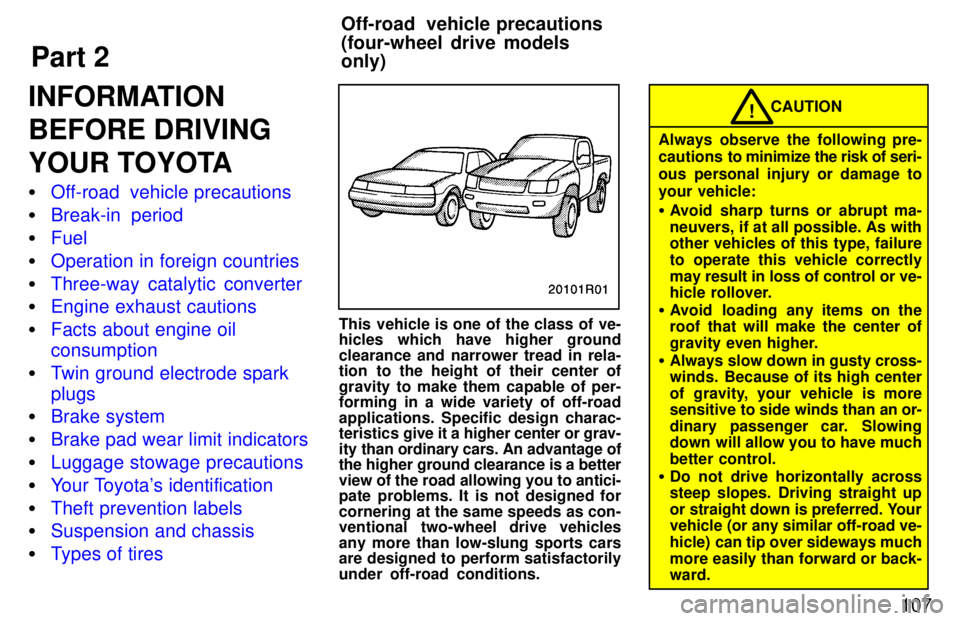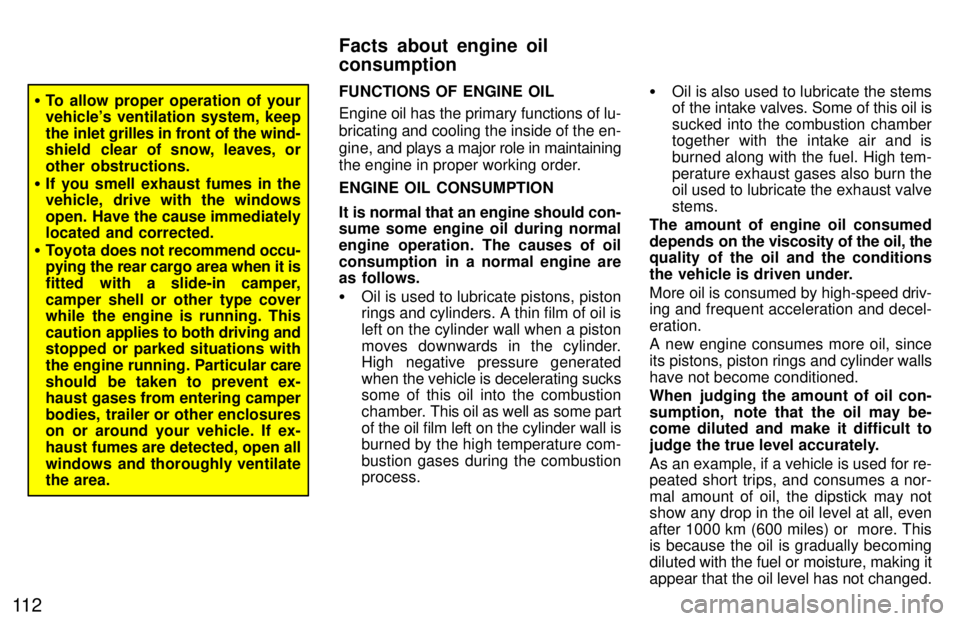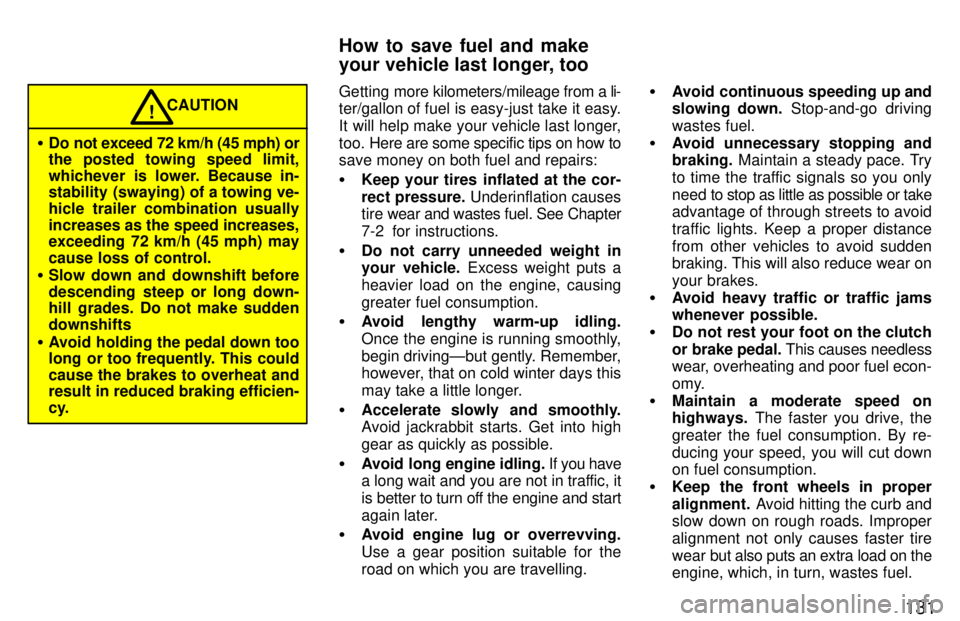1997 TOYOTA T100 fuel consumption
[x] Cancel search: fuel consumptionPage 72 of 212

68
The shift pattern is conventional as
shown above.
Press the clutch pedal down fully while
shifting, and then release it slowly. Do not
rest your foot on the pedal while driving,because it will cause clutch trouble. And do not use the clutch to hold the vehicle
when stopped on an uphill grade-use the
parking brake. Recommended shifting speeds
The transmission is fully synchronized
and upshifting or downshifting is easy.
For the best compromise between fuel
economy and vehicle performance, you
should upshift or downshift at the follow-
ing speeds: 3RZ-FE engine Low altitude Ð1219 m (4000 ft) or lower
gear km/h (mph)
1 to 2 or 2 to 1 24/16*1 (15/10* 1
)
2 to 3 or 3 to 2 43/30*1 (27/19* 1
)
3 to 4 or 4 to 3 64/48*1 (40/30* 1
)
4 to 5 or 5 to 4 74 (46)
High altitude ÐHigher than 1219 m (4000 ft) Upshifting
gear km/h (mph)
1 to 2 24 (15)
2 to 3 43/58* 2
(27/36* 2
)
3 to 4 64/72* 2
(40/45* 2
)
4 to 5 74/85* 2
(46/53* 2
)
Downshifting
gear km/h (mph)
2 to 1 25 (15)
3 to 2 43 (27)
4 to 3 64 (40)
5 to 4 72 (46)
* 1
: For constant-speed cruise or constant
speed cruise after deceleration.
* 2
: Applicable under heavy acceleration
conditions. 5VZ-FE engine
gear km/h (mph)
1 to 2 or 2 to 1 24 (15)
2 to 3 or 3 to 2 40 (25)
3 to 4 or 4 to 3 64 (40)
4 to 5 or 5 to 4 72 (45)
Upshifting too soon or downshifting too late will cause lugging, and possibly ping-
ing. Regularly revving the engine to maxi-
mum speed in each gear will cause exces-
sive engine wear and high fuel consumption.
Maximum allowable speeds
To get on a highway or to pass slower traf- fic, maximum acceleration may be neces-
sary. Make sure you observe the following
maximum allowable speeds in each gear:
Two-wheel drive models 1-ton models gear km/h (mph)
1 40 (25)
2 75 (47)
3 115 (71)
4 165 (103)
Manual transmission
Page 111 of 212

Part 2Off-road vehicle precautions (four-wheel drive models only)
107
INFORMATION
BEFORE DRIVING
YOUR TOYOTA �
Off-road vehicle precautions
�Break-in period
�Fuel
�Operation in foreign countries
�Three-way catalytic converter
�Engine exhaust cautions
�Facts about engine oil consumption
�Twin ground electrode spark plugs
�Brake system
�Brake pad wear limit indicators
�Luggage stowage precautions
�Your Toyota's identification
�Theft prevention labels
�Suspension and chassis
�Types of tires
This vehicle is one of the class of ve-
hicles which have higher ground
clearance and narrower tread in rela-
tion to the height of their center of
gravity to make them capable of per- forming in a wide variety of off-road applications. Specific design charac-
teristics give it a hi
gher center or grav-
ity than ordinary cars. An advantage ofthe higher ground clearance is a better view of the road allowing you to antici-
pate problems. It is not designed for
cornering at the same speeds as con-
ventional two-wheel drive vehicles
any more than low-slung sports cars
are designed to perform satisfactorily under off-road conditions.
CAUTION!
Always observe the following pre-
cautions to m inimize the risk of seri-
ous personal injury or damage to
your vehicle: � Avoid sharp turns or abrupt ma-
neuvers, if at all possible. As with
other vehicles of this type, failure
to operate this vehicle correctly
may result in loss of control or ve-
hicle rollover.
� Avoid loading any items on the
roof that will make the center of
gravity even higher.
� Always slow down in gusty cross-
winds. Because of its high center
of gravity, your vehicle is more
sensitive to side winds than an or-
dinary passenger car. Slowing
down will allow you to have much
better control.
� Do not drive horizontally across steep slopes. Driving straight up
or straight down is preferred. Your
vehicle (or any similar off-road ve-
hicle) can tip over sideways much
more easily than forward or back- ward.
Page 116 of 212

11 2
�To allow proper operation of your
vehicle's ventilation system, keep
the inlet grilles in front of the wind-
shield clear of snow, leaves, or
other obstructions.
� If you smell exhaust fumes in the
vehicle, drive with the windows
open. Have the cause immediately
located and corrected.
� Toyota does not recommend occu-
pying the rear cargo area when it is
fitted with a slide-in camper,camper shell or other type cover
while the engine is running. This
caution applies to both driving and
stopped or parked situations with
the engine running. Particular care
should be taken to prevent ex-
haust gases from entering camper
bodies, trailer or other enclosures
on or around your vehicle. If ex-
haust fumes are detected, open all
windows and thoroughly ventilate the area. FUNCTIONS OF ENGINE OIL
Engine oil has the primary functions of lu-
bricating and cooling the inside of the en-
gine,
and plays a major role in maintaining
the engine in proper working order. ENGINE OIL CONSUMPTION
It is normal that an engine should con-
sume some engine oil during normal
engine operation. The causes of oil
consumption in a normal engine are
as follows. � Oil is used to lubricate pistons, piston
rings and cylinders. A thin film of oil is left on the cylinder wall when a piston
moves downwards in the cylinder.
High negative pressure generated
when the vehicle is decelerating sucks
some of this oil into the combustion
chamber. This oil as well as some part
of the oil film left on the cylinder wall is
burned by the high temperature com-
bustion gases during the combustion process. �
Oil is also used to lubricate the stems
of the intake valves. Some of this oil is
sucked into the combustion chamber
together with the intake air and is
burned along with the fuel. High tem-perature exhaust gases also burn the
oil used to lubricate the exhaust valve stems.
The amount of engine oil consumed
depends on the viscosity of the oil, the
quality of the oil and the conditions
the vehicle is driven under.
More oil is consumed by high-speed driv-
ing and frequent acceleration and decel- eration.
A new engine consumes more oil, since
its pistons, piston rings and cylinder walls
have not become conditioned.
When judging the amount of oil con-
sumption, note that the oil may be- come diluted and make it difficult to
judge the true level accurately.
As an example, if a vehicle is used for re-
peated short trips, and consumes a nor- mal amount of oil, the dipstick may not
show any drop in the oil level at all, even after 1000 km (600 miles) or more. This is because the oil is gradually becoming
diluted with the fuel or moisture, making it
appear that the oil level has not changed.
Facts about engine oil consumption
Page 135 of 212

131
�Do not exceed 72 km/h (45 mph) or
the posted towing speed limit,
whichever is lower. Because in-
stability (swaying) of a towing ve-
hicle trailer combination usuallyincreases as the speed increases,
exceeding 72 km/h (45 mph) may cause loss of control.
� Slow down and downshift before
descending steep or long down-
hill grades. Do not make sudden downshifts
� Avoid holding the pedal down too
long or too frequently. This could
cause the brakes to overheat and
result in reduced braking efficien-
cy.
! CAUTION Getting
more kilometers/mileage from a li-
ter/gallon of fuel is easy-just take it easy.
It will help make your vehicle last longer,
too. Here are some specific tips on how to
save money on both fuel and repairs: � Keep your tires inflated at the cor- rect pressure. Underinflation causes
tire wear and wastes fuel. See Chapter
7-2 for instructions.
� Do not carry unneeded weight in
your vehicle. Excess weight puts a
heavier load on the engine, causing greater fuel consumption.
� Avoid lengthy warm-up idling.
Once the engine is running smoothly,
begin drivingÐbut gently. Remember,
however, that on cold winter days this
may take a little longer.
� Accelerate slowly and smoothly.
Avoid jackrabbit starts. Get into high
gear as quickly as possible.
� Avoid long engine idling. If you have
a long wait and you are not in traffic, it
is better to turn off the engine and start
again later.
� Avoid engine lug or overrevving.
Use a gear position suitable for the
road on which you are travelling. �
Avoid continuous speeding up and
slowing down. Stop-and-go driving
wastes fuel.
� Avoid unnecessary stopping andbraking. Maintain a steady pace. Try
to time the traffic signals so you only
need to stop as little as possible or take
advantage of through streets to avoid
traffic lights. Keep a proper distance
from other vehicles to avoid sudden braking. This will also reduce wear on your brakes.
� Avoid heavy traffic or traffic jams
whenever possible.
� Do not rest your foot on the clutch
or brake pedal. This causes needless
wear, overheating and poor fuel econ-
omy.
� Maintain a moderate speed on highways. The faster you drive, the
greater the fuel consumption. By re-
ducing your speed, you will cut down
on fuel consumption.
� Keep the front wheels in proper alignment. Avoid hitting the curb and
slow down on rough roads. Improper
alignment not only causes faster tire
wear but also puts an extra load on the
engine, which, in turn, wastes fuel.
How to save fuel and make
your vehicle last longer, too